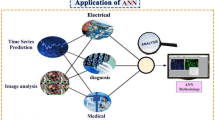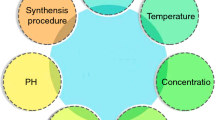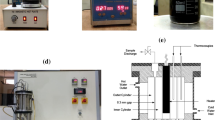Abstract
Nanofluids are employed in different thermal devices due to their enhanced thermophysical features which lead to noticeable heat transfer augmentation. One of the major reasons of the heat transfer improvement by using the nanofluids is their increased thermal conductivity. Several methods have been applied to estimate this property of nanofluids such as correlations and artificial neural networks (ANNs). In the present paper, group method of data handling (GMDH) and a mathematical correlation are proposed for forecasting the thermal conductivity of nanofluids containing CuO nanoparticles. The inputs of the both models are the base fluids’ thermal conductivities, concentration, temperature and nanoparticle dimension. Comparison of the forecasted data by these two approaches revealed more favorable performance of GMDH. The values of R-squared in the cases where polynomial and ANN were utilized were 0.9862 and 0.9996, respectively. Moreover, the average absolute relative deviation values were 5.25% and 0.881% for the indicated methods, respectively. According to these statistical values, it is concluded that employing the ANN-based regression leads to more confident model for forecasting the TC of the nanofluids containing CuO nanoparticles.









Similar content being viewed by others
Abbreviations
- \(a_{\text{i}}\) :
-
\(i\)th coefficient
- \(x\) :
-
Input vector
- \(x_{1}\) :
-
Temperature of nanofluid (°C)
- \(x_{2}\) :
-
Volume fraction of solid phase (%)
- \(x_{3}\) :
-
Size of particles (nm)
- \(x_{4}\) :
-
Thermal conductivity of the base fluid (W m−1 K−1)
- \(y\) :
-
Output vector
- \(y_{\text{i}}^{\text{experimental}}\) :
-
Measured data in experiment
- \(y_{\text{i}}^{\text{predicted}}\) :
-
Predicted value by the model
- AARD:
-
Average absolute relative deviation
- ANN:
-
Artificial neural network
- GMDH:
-
Group method of data handling
- MSE:
-
Mean square error
- RD:
-
Relative deviation
References
Mahian O, Kianifar A, Heris SZ, Wen D, Sahin AZ, Wongwises S. Nanofluids effects on the evaporation rate in a solar still equipped with a heat exchanger. Nano Energy. 2017;36:134–55. https://doi.org/10.1016/J.NANOEN.2017.04.025.
Ramezanizadeh M, Alhuyi Nazari M, Ahmadi MH, Açıkkalp E. Application of nanofluids in thermosyphons: a review. J Mol Liq. 2018;272:395–402. https://doi.org/10.1016/J.MOLLIQ.2018.09.101.
Mahian O, Kianifar A, Kleinstreuer C, Al-Nimr MA, Pop I, Sahin AZ, et al. A review of entropy generation in nanofluid flow. Int J Heat Mass Transf. 2013;65:514–32. https://doi.org/10.1016/J.IJHEATMASSTRANSFER.2013.06.010.
Karimipour A, D’Orazio A, Shadloo MS. The effects of different nano particles of Al2O3 and Ag on the MHD nano fluid flow and heat transfer in a microchannel including slip velocity and temperature jump. Phys E Low-Dimens Syst Nanostruct. 2017;86:146–53. https://doi.org/10.1016/J.PHYSE.2016.10.015.
Gandomkar A, Saidi MH, Shafii MB, Vandadi M, Kalan K. Visualization and comparative investigations of pulsating ferro-fluid heat. Appl Therm Eng. 2017. https://doi.org/10.1016/j.applthermaleng.2017.01.068.
Alhuyi Nazari M, Ahmadi MH, Ghasempour R, Shafii MB. How to improve the thermal performance of pulsating heat pipes: a review on working fluid. Renew Sustain Energy Rev. 2018;91:630–8. https://doi.org/10.1016/j.rser.2018.04.042.
Safaei MR, Safdari Shadloo M, Goodarzi MS, Hadjadj A, Goshayeshi HR, Afrand M, et al. A survey on experimental and numerical studies of convection heat transfer of nanofluids inside closed conduits. Adv Mech Eng. 2016;8:168781401667356. https://doi.org/10.1177/1687814016673569.
Ramezanizadeh M, Alhuyi Nazari M, Ahmadi MH, Chau K. Experimental and numerical analysis of a nanofluidic thermosyphon heat exchanger. Eng Appl Comput Fluid Mech. 2019;13:40–7. https://doi.org/10.1080/19942060.2018.1518272.
Nazari MA, Ghasempour R, Ahmadi MH, Heydarian G, Shafii MB. Experimental investigation of graphene oxide nanofluid on heat transfer enhancement of pulsating heat pipe. Int Commun Heat Mass Transf. 2018;91:90–4. https://doi.org/10.1016/j.icheatmasstransfer.2017.12.006.
Baghban A, Kahani M, Nazari MA, Ahmadi MH, Yan W-M. Sensitivity analysis and application of machine learning methods to predict the heat transfer performance of CNT/water nanofluid flows through coils. Int J Heat Mass Transf. 2019;128:825–35. https://doi.org/10.1016/J.IJHEATMASSTRANSFER.2018.09.041.
Hemmat Esfe M, Saedodin S, Mahian O, Wongwises S. Heat transfer characteristics and pressure drop of COOH-functionalized DWCNTs/water nanofluid in turbulent flow at low concentrations. Int J Heat Mass Transf. 2014;73:186–94. https://doi.org/10.1016/J.IJHEATMASSTRANSFER.2014.01.069.
Safaei M, Ahmadi G, Goodarzi M, Safdari Shadloo M, Goshayeshi H, Dahari M, et al. Heat transfer and pressure drop in fully developed turbulent flows of graphene nanoplatelets–silver/water nanofluids. Fluids. 2016;1:20. https://doi.org/10.3390/fluids1030020.
Shirzad M, Ajarostaghi SSM, Delavar MA, Sedighi K. Improve the thermal performance of the pillow plate heat exchanger by using nanofluid: numerical simulation. Adv Powder Technol. 2019;30:1356–65. https://doi.org/10.1016/J.APT.2019.04.011.
Ramezanizadeh M, Alhuyi Nazari M, Hossein Ahmadi M, Chen L. A review on the approaches applied for cooling fuel cells. Int J Heat Mass Transf. 2019;139:517–25. https://doi.org/10.1016/J.IJHEATMASSTRANSFER.2019.05.032.
Salavati Meibodi S, Kianifar A, Niazmand H, Mahian O, Wongwises S. Experimental investigation on the thermal efficiency and performance characteristics of a flat plate solar collector using SiO2/EG–water nanofluids. Int Commun Heat Mass Transf. 2015;65:71–5. https://doi.org/10.1016/J.ICHEATMASSTRANSFER.2015.02.011.
Toghyani S, Afshari E, Baniasadi E, Shadloo MS. Energy and exergy analyses of a nanofluid based solar cooling and hydrogen production combined system. Renew Energy. 2019;141:1013–25. https://doi.org/10.1016/J.RENENE.2019.04.073.
Ahmadi MH, Ramezanizadeh M, Nazari MA, Lorenzini G, Kumar R, Jilte R. Applications of nanofluids in geothermal: a review. Math Model Eng Probl. 2018;5:281–5. https://doi.org/10.18280/mmep.050402.
Kasaeian A, Eshghi AT, Sameti M. A review on the applications of nanofluids in solar energy systems. Renew Sustain Energy Rev. 2015;43:584–98. https://doi.org/10.1016/J.RSER.2014.11.020.
Natarajan E, Sathish R. Role of nanofluids in solar water heater. Int J Adv Manuf Technol. 2009. https://doi.org/10.1007/s00170-008-1876-8.
Ebaid MSY, Ghrair AM, Al-Busoul M. Experimental investigation of cooling photovoltaic (PV) panels using (TiO2) nanofluid in water–polyethylene glycol mixture and (Al2O3) nanofluid in water–cetyltrimethylammonium bromide mixture. Energy Convers Manag. 2018;155:324–43. https://doi.org/10.1016/J.ENCONMAN.2017.10.074.
Meibodi SS, Kianifar A, Mahian O, Wongwises S. Second law analysis of a nanofluid-based solar collector using experimental data. J Therm Anal Calorim. 2016;126:617–25. https://doi.org/10.1007/s10973-016-5522-7.
Ehyaei MA, Ahmadi A, Assad MEH, Hachicha AA, Said Z. Energy, exergy and economic analyses for the selection of working fluid and metal oxide nanofluids in a parabolic trough collector. Sol Energy. 2019;187:175–84. https://doi.org/10.1016/J.SOLENER.2019.05.046.
Said Z, Rahman SMA, El Haj Assad M, Alami AH. Heat transfer enhancement and life cycle analysis of a shell-and-tube heat exchanger using stable CuO/water nanofluid. Sustain Energy Technol Assess. 2019;31:306–17. https://doi.org/10.1016/J.SETA.2018.12.020.
Said Z, El Haj Assad M, Hachicha AA, Bellos E, Abdelkareem MA, Alazaizeh DZ, et al. Enhancing the performance of automotive radiators using nanofluids. Renew Sustain Energy Rev. 2019;112:183–94. https://doi.org/10.1016/J.RSER.2019.05.052.
Ahmadi MH, Mirlohi A, Alhuyi Nazari M, Ghasempour R. A review of thermal conductivity of various nanofluids. J Mol Liq. 2018. https://doi.org/10.1016/j.molliq.2018.05.124.
Hemmat Esfe M, Saedodin S, Bahiraei M, Toghraie D, Mahian O, Wongwises S. Thermal conductivity modeling of MgO/EG nanofluids using experimental data and artificial neural network. J Therm Anal Calorim. 2014;118:287–94. https://doi.org/10.1007/s10973-014-4002-1.
Hemmat Esfe M, Saedodin S, Mahian O, Wongwises S. Thermal conductivity of Al2O3/water nanofluids. J Therm Anal Calorim. 2014;117:675–81. https://doi.org/10.1007/s10973-014-3771-x.
Ramezanizadeh M, Alhuyi Nazari M, Ahmadi MH, Lorenzini G, Pop I. A review on the applications of intelligence methods in predicting thermal conductivity of nanofluids. J Therm Anal Calorim. 2019. https://doi.org/10.1007/s10973-019-08154-3.
Ahmadi M-A, Ahmadi MH, Fahim Alavi M, Nazemzadegan MR, Ghasempour R, Shamshirband S. Determination of thermal conductivity ratio of CuO/ethylene glycol nanofluid by connectionist approach. J Taiwan Inst Chem Eng. 2018. https://doi.org/10.1016/J.JTICE.2018.06.003.
Ahmadi MH, Alhuyi Nazari M, Ghasempour R, Madah H, Shafii MB, Ahmadi MA. Thermal conductivity ratio prediction of Al2O3/water nanofluid by applying connectionist methods. Colloids Surf A Physicochem Eng Asp. 2018. https://doi.org/10.1016/j.colsurfa.2018.01.030.
Ahmadi MH, Hajizadeh F, Rahimzadeh M, Shafii MB, Chamkha AJ. Application GMDH artificial neural network for modeling of Al2O3/water and Al2O3/ethylene glycol thermal conductivity. Int J Heat Technol. 2018;36:773–82.
Sepyani K, Afrand M, Hemmat Esfe M. An experimental evaluation of the effect of ZnO nanoparticles on the rheological behavior of engine oil. J Mol Liq. 2017;236:198–204. https://doi.org/10.1016/J.MOLLIQ.2017.04.016.
Ahmadi Nadooshan A, Hemmat Esfe M, Afrand M. Evaluation of rheological behavior of 10W40 lubricant containing hybrid nano-material by measuring dynamic viscosity. Phys E Low-Dimens Syst Nanostruct. 2017;92:47–54. https://doi.org/10.1016/J.PHYSE.2017.05.011.
Zhang W, Maleki A, Rosen MA. A heuristic-based approach for optimizing a small independent solar and wind hybrid power scheme incorporating load forecasting. J Clean Prod. 2019. https://doi.org/10.1016/J.JCLEPRO.2019.117920.
Maleki A, Khajeh MG, Rosen MA. Two heuristic approaches for the optimization of grid-connected hybrid solar–hydrogen systems to supply residential thermal and electrical loads. Sustain Cities Soc. 2017;34:278–92. https://doi.org/10.1016/J.SCS.2017.06.023.
Maleki A, Hajinezhad A, Rosen MA. Modeling and optimal design of an off-grid hybrid system for electricity generation using various biodiesel fuels: a case study for Davarzan, Iran. Biofuels. 2016;7:699–712. https://doi.org/10.1080/17597269.2016.1192443.
Malekan M, Khosravi A, Goshayeshi HR, Assad MEH, Garcia Pabon JJ. Thermal resistance modeling of oscillating heat pipes for nanofluids by artificial intelligence approach. J Heat Transf. 2019. https://doi.org/10.1115/1.4043569.
Maleki A, Khajeh MG, Rosen MA. Weather forecasting for optimization of a hybrid solar-wind–powered reverse osmosis water desalination system using a novel optimizer approach. Energy. 2016;114:1120–34. https://doi.org/10.1016/J.ENERGY.2016.06.134.
Gholipour Khajeh M, Maleki A, Rosen MA, Ahmadi MH. Electricity price forecasting using neural networks with an improved iterative training algorithm. Int J Ambient Energy. 2018;39:147–58. https://doi.org/10.1080/01430750.2016.1269674.
Ahmadi Nadooshan A, Hemmat Esfe M, Afrand M. Prediction of rheological behavior of SiO2-MWCNTs/10W40 hybrid nanolubricant by designing neural network. J Therm Anal Calorim. 2018;131:2741–8. https://doi.org/10.1007/s10973-017-6688-3.
Pakatchian MR, Saeidi H, Ziamolki A. CFD-based blade shape optimization of MGT-70(3)axial flow compressor. Int J Numer Methods Heat Fluid Flow. 2019. https://doi.org/10.1108/HFF-10-2018-0603.
Ahmadi MH, Tatar A, Alhuyi Nazari M, Ghasempour R, Chamkha AJ, Yan W-M. Applicability of connectionist methods to predict thermal resistance of pulsating heat pipes with ethanol by using neural networks. Int J Heat Mass Transf. 2018. https://doi.org/10.1016/j.ijheatmasstransfer.2018.06.085.
Ahmadi MH, Sadeghzadeh M, Raffiee AH, Chau K. Applying GMDH neural network to estimate the thermal resistance and thermal conductivity of pulsating heat pipes. Eng Appl Comput Fluid Mech. 2019;13:327–36. https://doi.org/10.1080/19942060.2019.1582109.
Zhang W, Maleki A, Rosen MA, Liu J. Sizing a stand-alone solar-wind-hydrogen energy system using weather forecasting and a hybrid search optimization algorithm. Energy Convers Manag. 2019;180:609–21. https://doi.org/10.1016/J.ENCONMAN.2018.08.102.
Rezaei MH, Sadeghzadeh M, Alhuyi Nazari M, Ahmadi MH, Astaraei FR. Applying GMDH artificial neural network in modeling CO2 emissions in four nordic countries. Int J Low-Carbon Technol. 2018;13:266–71. https://doi.org/10.1093/ijlct/cty026.
Mohamadian F, Eftekhar L, Haghighi Bardineh Y. Applying GMDH artificial neural network to predict dynamic viscosity of an antimicrobial nanofluid. Nanomed J. 2018;5:217–21. https://doi.org/10.22038/NMJ.2018.05.00005.
Hemmat Esfe M, Bahiraei M, Hajmohammad MH, Afrand M. Rheological characteristics of MgO/oil nanolubricants: experimental study and neural network modeling. Int Commun Heat Mass Transf. 2017;86:245–52. https://doi.org/10.1016/J.ICHEATMASSTRANSFER.2017.05.017.
Ahmadi MH, Ahmadi MA, Nazari MA, Mahian O, Ghasempour R. A proposed model to predict thermal conductivity ratio of Al2O3/EG nanofluid by applying least squares support vector machine (LSSVM) and genetic algorithm as a connectionist approach. J Therm Anal Calorim. 2019;135:271–81. https://doi.org/10.1007/s10973-018-7035-z.
Zendehboudi A, Saidur R, Mahbubul IM, Hosseini SH. Data-driven methods for estimating the effective thermal conductivity of nanofluids: a comprehensive review. Int J Heat Mass Transf. 2019;131:1211–31. https://doi.org/10.1016/J.IJHEATMASSTRANSFER.2018.11.053.
Pham DT, Liu X. Modelling and prediction using GMDH networks of Adalines with nonlinear preprocessors. Int J Syst Sci. 1994;25:1743–59. https://doi.org/10.1080/00207729408949310.
Ramezanizadeh M, Alhuyi Nazari M. Modeling thermal conductivity of Ag/water nanofluid by applying a mathematical correlation and artificial neural network. Int J Low-Carbon Technol. 2019. https://doi.org/10.1093/ijlct/ctz030.
Zoqi M, Ghamgosar M, Ganji M, Fallahi S. Application of GMDH and genetic algorithm in fraction in biogas from landfill modeling. J Environ Sci Technol. 2016;18:1–12.
Ahmadi MH, Ahmadi MA, Mehrpooya M, Rosen MA. Using GMDH neural networks to model the power and torque of a stirling engine. Sustainability. 2015;7:2243–55. https://doi.org/10.3390/su7022243.
Pourkiaei SM, Ahmadi MH, Hasheminejad SM. Modeling and experimental verification of a 25 W fabricated PEM fuel cell by parametric and GMDH-type neural network. Mech Ind. 2016;17:105. https://doi.org/10.1051/meca/2015050.
Ramezanizadeh M, Ahmadi MA, Ahmadi MH, Alhuyi Nazari M. Rigorous smart model for predicting dynamic viscosity of Al2O3/water nanofluid. J Therm Anal Calorim. 2018. https://doi.org/10.1007/s10973-018-7916-1.
Ramezanizadeh M, Ahmadi MH, Nazari MA, Sadeghzadeh M, Chen L. A review on the utilized machine learning approaches for modeling the dynamic viscosity of nanofluids. Renew Sustain Energy Rev. 2019;114:109345. https://doi.org/10.1016/J.RSER.2019.109345.
Hemmat Esfe M, Motahari K, Sanatizadeh E, Afrand M, Rostamian H, Reza Hassani Ahangar M. Estimation of thermal conductivity of CNTs-water in low temperature by artificial neural network and correlation. Int Commun Heat Mass Transf. 2016;76:376–81. https://doi.org/10.1016/J.ICHEATMASSTRANSFER.2015.12.012.
Adhami Dehkordi R, Hemmat Esfe M, Afrand M. Effects of functionalized single walled carbon nanotubes on thermal performance of antifreeze: an experimental study on thermal conductivity. Appl Therm Eng. 2017;120:358–66. https://doi.org/10.1016/J.APPLTHERMALENG.2017.04.009.
Asadi A, Asadi M, Rezaniakolaei A, Rosendahl LA, Afrand M, Wongwises S. Heat transfer efficiency of Al2O3-MWCNT/thermal oil hybrid nanofluid as a cooling fluid in thermal and energy management applications: an experimental and theoretical investigation. Int J Heat Mass Transf. 2018;117:474–86. https://doi.org/10.1016/J.IJHEATMASSTRANSFER.2017.10.036.
Agarwal R, Verma K, Agrawal NK, Duchaniya RK, Singh R. Synthesis, characterization, thermal conductivity and sensitivity of CuO nanofluids. Appl Therm Eng. 2016;102:1024–36. https://doi.org/10.1016/j.applthermaleng.2016.04.051.
Liu M-S, Lin MC-C, Huang I-T, Wang C-C. Enhancement of thermal conductivity with CuO for nanofluids. Chem Eng Technol. 2006;29:72–7. https://doi.org/10.1002/ceat.200500184.
Lee S, Choi SU-S, Li S, Eastman JA. Measuring thermal conductivity of fluids containing oxide nanoparticles. J Heat Transf. 1999;121:280. https://doi.org/10.1115/1.2825978.
Wang X, Xu X, Choi SU S. Thermal Conductivity of nanoparticle—fluid mixture. J Thermophys Heat Transf. 1999;13:474–80. https://doi.org/10.2514/2.6486.
Liu M, Lin M, Wang C. Enhancements of thermal conductivities with Cu, CuO, and carbon nanotube nanofluids and application of MWNT/water nanofluid on a water chiller system. Nanoscale Res Lett. 2011;6:297. https://doi.org/10.1186/1556-276X-6-297.
Das SK, Putra N, Thiesen P, Roetzel W. Temperature dependence of thermal conductivity enhancement for nanofluids. J Heat Transfer. 2003;125:567. https://doi.org/10.1115/1.1571080.
Mintsa HA, Roy G, Nguyen CT, Doucet D. New temperature dependent thermal conductivity data for water-based nanofluids. Int J Therm Sci. 2009;48:363–71. https://doi.org/10.1016/J.IJTHERMALSCI.2008.03.009.
Khedkar RS, Sonawane SS, Wasewar KL. Influence of CuO nanoparticles in enhancing the thermal conductivity of water and monoethylene glycol based nanofluids. Int Commun Heat Mass Transf. 2012;39:665–9. https://doi.org/10.1016/j.icheatmasstransfer.2012.03.012.
Author information
Authors and Affiliations
Corresponding author
Additional information
Publisher's Note
Springer Nature remains neutral with regard to jurisdictional claims in published maps and institutional affiliations.
Appendix
Appendix
Rights and permissions
About this article
Cite this article
Komeilibirjandi, A., Raffiee, A.H., Maleki, A. et al. Thermal conductivity prediction of nanofluids containing CuO nanoparticles by using correlation and artificial neural network. J Therm Anal Calorim 139, 2679–2689 (2020). https://doi.org/10.1007/s10973-019-08838-w
Received:
Accepted:
Published:
Issue Date:
DOI: https://doi.org/10.1007/s10973-019-08838-w




